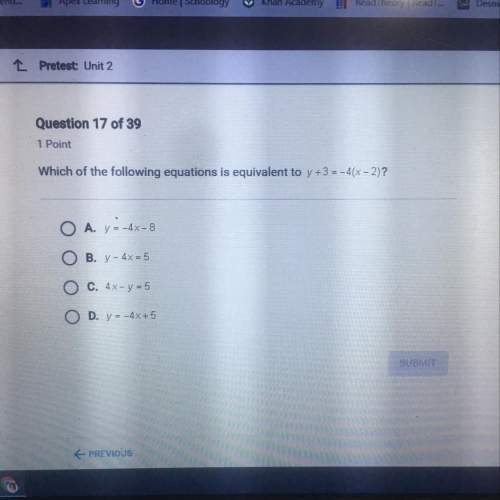
Mathematics, 31.07.2019 21:30 caldonia2018
Which statement is true about the function f(x)=-√-x a. the domain of the function is all negative real numbers. b. the range of the function is all positive real numbers. c. the domain and range of the function have opposite signs. d. the domain and range of the function are the same.

Answers: 2


Other questions on the subject: Mathematics

Mathematics, 21.06.2019 16:40, Alex9089435028
The sum of two numbers is 86, and their difference is 20. find the two numbers
Answers: 2

Mathematics, 21.06.2019 21:00, deondra0803
Val and tony get paid per project. val is paid a project fee of $44 plus $12 per hour. tony is paid a project fee of $35 plus $15 per hour. write an expression to represent how much a company will pay to hire both to work the same number of hours on a project.
Answers: 1

Mathematics, 21.06.2019 22:00, deannajd03
Which two transformations are applied to pentagon abcde to create a'b'c'd'e'? (4 points) translated according to the rule (x, y) ? (x + 8, y + 2) and reflected across the x-axis translated according to the rule (x, y) ? (x + 2, y + 8) and reflected across the y-axis translated according to the rule (x, y) ? (x + 8, y + 2) and reflected across the y-axis translated according to the rule (x, y) ? (x + 2, y + 8) and reflected across the x-axis
Answers: 1

Mathematics, 22.06.2019 00:30, gthif13211
I've been working on this for a few days and i just don't understand, it's due in a few hours. you. the direction of a vector is defined as the angle of the vector in relation to a horizontal line. as a standard, this angle is measured counterclockwise from the positive x-axis. the direction or angle of v in the diagram is α. part a: how can you use trigonometric ratios to calculate the direction α of a general vector v = < x, y> similar to the diagram? part b suppose that vector v lies in quadrant ii, quadrant iii, or quadrant iv. how can you use trigonometric ratios to calculate the direction (i. e., angle) of the vector in each of these quadrants with respect to the positive x-axis? the angle between the vector and the positive x-axis will be greater than 90 degrees in each case. part c now try a numerical problem. what is the direction of the vector w = < -1, 6 > ?
Answers: 1
You know the right answer?
Which statement is true about the function f(x)=-√-x a. the domain of the function is all negative r...
Questions in other subjects:


Mathematics, 04.09.2020 14:01



History, 04.09.2020 14:01



Mathematics, 04.09.2020 14:01


Health, 04.09.2020 14:01






